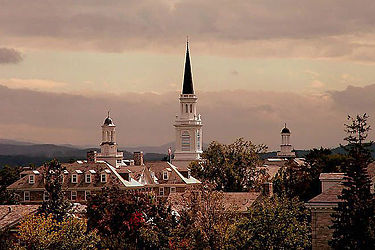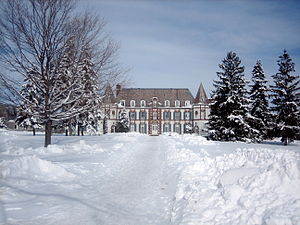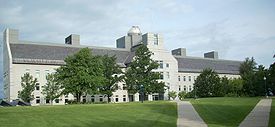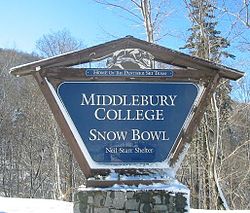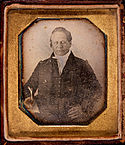- Middlebury College
-
Coordinates: 44°00′32″N 73°10′38″W / 44.00889°N 73.17722°W
Middlebury College 
Middlebury College sealLatin: Collegium Medioburiense Viridis Montis
"Middlebury College in the Green Mountains"Motto Scientia et Virtus Motto in English Knowledge and Virtue Established 1800 Type Private Endowment US $854 million[1] President Ronald D. Liebowitz Academic staff 311 Undergraduates 2,482 Location  Middlebury, Vermont, United States
Middlebury, Vermont, United StatesCampus Rural, 350 acres (1.4 km²) (main campus);
1,800 acres (7.3 km²) (Bread Loaf Mountain campus)Colors blue and white Sports 31 varsity teams
NESCAC
NCAA Division III
Middlebury PanthersNickname Midd, Club Midd [2] Website middlebury.edu 
Middlebury College is a private liberal arts college located in Middlebury, Vermont, USA. Founded in 1800, it is one of the oldest liberal arts colleges in the United States. Drawing 2,400 undergraduates from all 50 United States and over 70 countries, Middlebury offers 44 majors in the arts, humanities, literature, foreign languages, social sciences, and natural sciences. Middlebury follows a 4–1–4 academic schedule, with two four-course semesters and a one-course January term. Middlebury is one of the "Little Ivies." Middlebury is the first American institution of higher education to have granted a bachelor's degree to an African-American, graduating Alexander Twilight in the class of 1823.[3] Middlebury was also one of the first formerly all-male liberal arts colleges in New England to become a coeducational institution, following the trustees' decision in 1883 to accept women. In addition to its core undergraduate program, the College organizes undergraduate and graduate programs in modern languages, English literature, and writing. The Middlebury College Language Schools offer instruction in 10 languages. The Bread Loaf School of English is a summer graduate program in English literature, and the Bread Loaf Writers' Conference is one of the oldest writers' conferences in the country. The College also operates 37 C.V. Starr-Middlebury Schools Abroad in 16 countries across 5 continents. The Monterey Institute of International Studies is a graduate school of Middlebury College. The Institute enrolls graduate students in the fields of international relations, international business, language teaching, and language translation and interpretation.[4] Middlebury's 31 varsity teams are known as the Middlebury Panthers and compete in the Division III NESCAC conference.
Contents
- 1 History
- 2 Academics
- 3 Profile
- 4 Campus
- 5 Student life
- 6 New England Review
- 7 Athletics
- 8 Middlebury people
- 9 Middlebury in popular culture
- 10 See also
- 11 References
- 12 External links
History
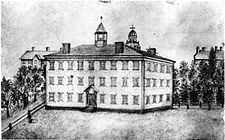 A sketch of "East College", Middlebury's first building, a simple wood-framed structure completed in 1798 and razed in 1867. Twilight Hall now sits adjacent to the site. Old Stone Row is pictured in the background.[5]
A sketch of "East College", Middlebury's first building, a simple wood-framed structure completed in 1798 and razed in 1867. Twilight Hall now sits adjacent to the site. Old Stone Row is pictured in the background.[5]
Founding and 19th century
Middlebury received its founding charter on November 1, 1800, as an outgrowth of the Addison County Grammar School, which had been founded three years earlier in 1797. The College's first president—Jeremiah Atwater—began classes a few days later, making Middlebury the first operating college or university in Vermont.[6] One student named Aaron Petty graduated at the first commencement held in August 1802.[7]
The College's founding religious affiliation was loosely Congregationalist. Yet the idea for a college was that of town fathers rather than clergymen, and Middlebury was clearly "the Town's College" rather than the Church's. Chief among its founders were Seth Storrs and Gamaliel Painter, the former credited with the idea for a college [8] and the latter as its greatest early benefactor. In addition to receiving a diploma upon graduation, Middlebury graduates also receive a replica of Gamaliel Painter's cane. Painter bequeathed his original cane to the College and it is carried by the College President at official occasions including first-year convocation and graduation.
Alexander Twilight, class of 1823, was the first black graduate of any college or university in the United States; he also became the first African American elected to public office, joining the Vermont House of Representatives in 1836. At its second commencement in 1804, Middlebury granted Lemuel Haynes an honorary master's degree, the first advanced degree ever bestowed upon an African American.[9][10]
In 1883, the trustees voted to accept women as students in the college, making Middlebury one of the first formerly all-male liberal arts colleges in New England to become a coeducational institution. The first female graduate—May Belle Chellis—received her degree in 1886.[11]. As valedictorian of the class of 1899, Mary Annette Anderson became the first African American woman elected to Phi Beta Kappa.
20th century
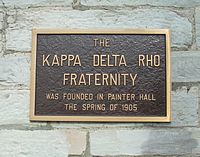 Sign on Painter Hall commemorating the 1905 founding of national fraternity Kappa Delta Rho
Sign on Painter Hall commemorating the 1905 founding of national fraternity Kappa Delta Rho
The College’s centennial in 1900 began a century of physical expansion beyond the three buildings of Old Stone Row. York and Sawyer designed the Egbert Starr Library (1900), a Beaux-Arts edifice later expanded and renamed the Axinn Center, and Warner Hall (1901). Growth in enrollment and the endowment led to continued expansion westward. McCullough Hall (1912) and Voter Hall (1913) featured gymnasium and laboratories, respectively, adopting Georgian Revival styling while confirming the campus standard of grey Vermont marble.[12]
The national fraternity Kappa Delta Rho was founded in Painter Hall on May 17, 1905. Middlebury College abolished fraternities in the early 1990s, but the organization continued on campus in the less ritualized form of a social house. Due to a policy at the school against single-sex organizations, the house was forced to coeducate during the same period as well.[13]
The German Language School, founded in 1915 under the supervision of then-President John Martin Thomas, began the tradition of the Middlebury College Language Schools. These Schools, which take place on the Middlebury campus during the summer, enroll about 1,350 students in the Arabic, Chinese, French, German, Hebrew, Italian, Japanese, Portuguese, Russian, and Spanish Language Schools.[14]
Middlebury President Paul Moody began the American tradition of a National Christmas Tree in 1923 when the College donated a 48-foot balsam fir for use at the White House.[15] The tree was illuminated when Calvin Coolidge, a Vermont-native in the first year of his presidency, flipped an electric switch.
The Bread Loaf School of English, Middlebury's graduate school of English, was established at the College's Bread Loaf Mountain campus in 1920.[16] The Bread Loaf Writers' Conference was established in 1926. In 1978, the Bread Loaf School of English expanded to include a campus at Lincoln College, Oxford University. In 1991, the School expanded to include a campus at St. John's College in New Mexico, and to the University of North Carolina, Asheville, in 2006.[16]
The C.V. Starr-Middlebury Schools Abroad began in 1949 with the school in Paris; they now host students at 37 sites in Argentina, Brazil, China, Cameroon, Chile, Egypt, France, Germany, Italy, Israel, Japan, Jordan, Mexico, Russia, Spain, and Uruguay.[17]
The second half of the 20th Century accelerated Middlebury’s transition from a small, regional institution to a top-tier liberal arts college with an international presence.[18] Campus growth continued. In 1965, Middlebury established its Environmental Studies program, creating the first undergraduate Environmental Studies program in the U.S.[19] Nationally-affiliated fraternities were abolished in 1991; some chose to become co-educational social houses which continue today.[20]
21st century
 Old Chapel with the Green Mountains in the distance
Old Chapel with the Green Mountains in the distance
In May 2004, an anonymous benefactor made a $50 million donation to Middlebury. It was the largest cash gift the school has ever received. The donor asked only that Middlebury name its recently built science building, Bicentennial Hall, after outgoing President John McCardell Jr. In June 2011, Middlebury's endowment stood at approximately $908 million.[21]
In 2005, Middlebury signed an affiliation agreement with the Monterey Institute of International Studies, a graduate school in Monterey, California. While the Monterey Institute initially remained a separate institution, the affiliation saved MIIS from financial difficulties. On June 30, 2010, the Monterey Institute was officially designated as a graduate school of Middlebury College.[22]
In the summer of 2008, Middlebury and the Monterey Institute launched a collaborative program to offer summer language immersion programs in Arabic, Chinese, French, German, Italian, and Spanish to middle and high school students through the Middlebury-Monterey Language Academy (MMLA).
In June 2010, Middlebury announced that it had a 40% stake in a joint-venture with K12 Inc. to build online language software to be marketed under the brand "Middlebury Interactive Languages."[23] The initial release will cover basic Spanish and French and be aimed at high school students.
Academics
Undergraduate college
Overview
Founded in 1800, the college enrolls approximately 2,350 undergraduates from all 50 states and 70 countries. The college offers 40 undergraduate departments and programs. Middlebury was the first institution of higher education in the United States to offer an environmental studies major, establishing the major in 1965.[19]
The most popular majors at Middlebury by number of recent graduates are: economics, international studies, English and American literatures, political science, psychology, and environmental studies.[24] Close to 40 percent of graduating seniors choose a single major in a traditional academic discipline, and about 30 percent of students complete a double or joint major combining two disciplines. Another 30 percent of students major in one of the College's interdisciplinary programs.[25]
4–1–4 calendar
The academic year follows a 4–1–4 schedule of two four-course semesters plus a Winter Term session in January. The Winter Term, often called "J-Term", allows students to enroll in one intensive course, pursue independent research, or complete an off-campus internship.
Summer language schools
Main article: Middlebury College Language SchoolsThe Middlebury College Language Schools, started with the establishment of the School of German in 1915, offer intensive instruction in 10 languages during six-, seven-, or eight-week summer sessions. The schools enroll about 1,350 students every summer. The Schools all use an immersion-based approach to language instruction and acquisition. All students in the Language Schools must sign and abide by Middlebury's "Language Pledge," a pledge to use their target language exclusively during the duration of their time at the School.[26]
Undergraduate instruction, available to undergraduate students, government employees and individuals from professional backgrounds, is offered in Arabic, Chinese, French, German, Hebrew, Italian, Japanese, Portugese, Russian, and Spanish.[27]
Middlebury's Language Schools have historically been conducted at the College's campus in Vermont. In the summer of 2009 the college opened a satellite campus at Mills College in Oakland, California to accommodate a growth in enrollment. For the summer of 2011, Middlebury at Mills will offer Arabic, French, Japanese, and Spanish instruction. Students in French and Spanish may opt to study at either the Middlebury or Mills campuses.
Graduate programs
Monterey Institute of International Studies
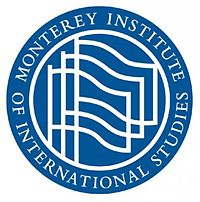 Seal of the Monterey Institute of International Studies, a Graduate School of Middlebury
Seal of the Monterey Institute of International Studies, a Graduate School of Middlebury Main article: Monterey Institute of International Studies
Main article: Monterey Institute of International StudiesThe Monterey Institute of International Studies, in Monterey, California became an affiliate of Middlebury following the signing of an affiliation agreement between the two in December 2005. In Summer 2010, the Institute was formally designated as “a graduate school of Middlebury College.” The Institute currently enrolls 790 graduate students in the fields of international relations, international business, language teaching, and translation and interpretation. The Institute is the only school in the Western Hemisphere offering graduate degrees in conference interpretation and in translation and interpretation between English-Chinese, English-Japanese and English-Korean. It is also one of the few schools with a bilingual requirement upon enrollment for all students. English is required for non-native speakers and two years of university-level language classes in either Spanish, French, German, Japanese, Chinese (Mandarin), Russian, or Arabic for native English speakers.
Summer Language Schools and Doctor of Modern Languages (D.M.L.)
Main article: Middlebury College Language SchoolsMain article: Doctor of Modern LanguagesSix of Middlebury's summer schools — Chinese, French, German, Italian, Russian, and Spanish — offer graduate programs in addition to the undergraduate component. These are completed during six-week summer sessions, with an option of combining the sessions with overseas study. The graduate degree most often conferred is the Master of Arts. The MA in German requires one summer on the Middlebury campus. A second summer is required for the MA in Russian, Chinese, and Mediterranean Studies; it is optional for the MA in French, Italian, and Spanish.[28]
Middlebury offers a Doctor of Modern Languages (D.M.L.) degree. Unique to Middlebury, the D.M.L. prepares teacher-scholars in two modern foreign languages, helping them develop as teachers of second-language acquisition, literature, linguistics, and language pedagogy.[28]
Bread Loaf School of English
Main article: Bread Loaf School of EnglishThe Bread Loaf School of English is based at the college's Bread Loaf Mountain campus in Ripton, just outside Middlebury, in sight of the main ridge of the Green Mountains. The poet Robert Frost is credited as a major influence on the school. Frost "first came to the School on the invitation of Dean Wilfred Davison in 1921. Friend and neighbor to Bread Loaf, (he) returned to the School every summer with but three exceptions for 42 years."[29] Every summer since 1920, Bread Loaf has offered students from around the United States and the world intensive courses in literature, creative writing, the teaching of writing, and theater. Prominent faculty and staff have included William Carlos Williams, Bernard DeVoto, Edward Weismiller, Theodore Roethke, John Crowe Ransom, Elizabeth Drew, A. Bartlett Giamatti, Perry Miller, Catherine Drinker Bowen, Carlos Baker, Harold Bloom, Cleanth Brooks, Charles Edward Eaton, Richard Ellman, Paul Muldoon, William Sloane, John Ciardi, John P. Marquand, Wylie Sypher, and Dixie Goswami.[29][30]
The Bread Loaf School has campuses at four locations: Vermont, Oxford (England), North Carolina, and New Mexico. The primary campus, near Middlebury, enrolls some 250 students every summer. The Oxford University campus (at Lincoln College) enrolls 90 students. The North Carolina campus, near the Blue Ridge Mountains, is affiliated with the University of North Carolina at Asheville, and enrolled its first class of 50 students in 2006. The New Mexico campus at St. John's College, Santa Fe, enrolls 80 students every summer.
Students at Bread Loaf can either attend for one or two summers as continuing graduate students, or work toward a Master of Arts (M.A.) or Master of Letters (M.Litt.) degree over the course of four or five summers spread over different campuses.
C.V. Starr-Middlebury Schools Abroad
Main article: C.V. Starr-Middlebury Schools AbroadThe C.V. Starr-Middlebury Schools Abroad, operated by Middlebury College in 16 countries across 5 continents, offer overseas academic programs for undergraduates from various U.S. institutions, as well as graduate-level programs for students from Middlebury College’s Language Schools and the Monterey Institute of International Studies. The first School was the School in Paris, opened in 1949. The C.V. Starr-Middlebury Schools have been endowed by the C.V. Starr Foundation.
The C.V. Starr-Middlebury Schools have an immersion-based approach to language and cultural acquisition. All students must sign Middlebury's "Language Pledge," agreeing to exclusively use their target language for the duration of the program.[31]
The 2011 Princeton Review ranked Middlebury's study abroad programs as the #6 most popular in the United States.[32]
The college operates schools abroad at 37 locations, including: Argentina (Buenos Aires and Tucumán); Brazil (Belo Horizonte, Florianópolis, and Niteroi); Cameroon (Yaoundé); Chile (Concepción, La Serena, Santiago, Temuco, Valdivia, and Valparaíso); China (Beijing, Hangzhou, and Kunming); Egypt (Alexandria); France (Paris, Poitiers, and Bordeaux); Germany (Berlin and Mainz); Italy (Ferrara and Florence); Israel (Beer Sheva); Japan (Tokyo); Jordan (Amman); Mexico (Guadalajara and Xalapa); Russia (Irkutsk, Moscow, and Yaroslavl); Spain (Cordoba, Getafe, Logroño, and Madrid); and Uruguay (Montevideo).[12]
Research centers
Rohatyn Center for International Affairs (RCFIA)
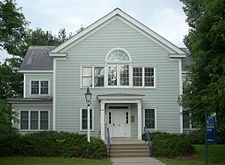 The Robert A. Jones '59 house, home of the Rohatyn Center for International Affairs.
The Robert A. Jones '59 house, home of the Rohatyn Center for International Affairs.
The Rohatyn Center for International Affairs,[33] was founded by Felix Rohatyn '49, investment banker, former U.S. Ambassador to France, and founder of Rohatyn Associates. Located at the Robert A. Jones '59 House, the center combines Middlebury's strengths in political, linguistic, and cultural studies to offer internationally focused symposia, lectures, and presentations. An internationally oriented resource and research center, the Rohatyn Center for International Affairs (RCFIA) supports the College's goal of advancing global understanding that radiates from a core linguistic and cultural competency. The center regularly publishes working papers by prominent international scholars and offers grants for faculty and student research.[34]
Center for the Comparative Study of Race and Ethnicity (CCSRE)
The Center for the Comparative Study of Race and Ethnicity,[35] engages in interdisciplinary and comparative approaches for understanding formations of race and ethnicity and their effects on human relations. It supports scholarship that considers race and ethnicity as intersecting with class, gender, sexuality, religion, age, disability, language, communication, migration and the environment. Work supported by the Center situates these discussions in local, regional, global, and transnational contexts. The CCSRE draws on Middlebury College's expertise in international studies, environmental studies, and language and communication to support critical inquiry on race, ethnicity and diversity.[36]
Bread Loaf Writers' Conference
Main article: Bread Loaf Writers' ConferenceIn addition to the six-week summer program, Middlebury College's Bread Loaf campus is also the site of the Bread Loaf Writers' Conference for established authors, founded in 1926. It was called by The New Yorker "the oldest and most prestigious writers' conference in the country."[37] "Two weeks of intensive workshops, lectures, classes and readings present writers with rigorous practical and theoretical approaches to their craft, and offer a model of literary instruction."[38]
Noted authors who have been associated with the conference over the years include James Brown, John Ciardi, Bernard DeVoto, Robert Frost, John Gardner, Richard Gehman, Donald Hall, John Irving, Shirley Jackson, Barry Lopez, Robie Macauley, Carson McCullers, Norman Mailer, Toni Morrison, Linda Pastan, May Sarton, Anne Sexton, Eudora Welty, and Richard Yates.[39]
Recent faculty have included Julia Alvarez, Andrea Barrett, Charles Baxter, Linda Bierds, Robert Boswell, Lan Samantha Chang, Ted Conover, Mark Doty, Percival Everett, Lynn Freed, Linda Gregerson, Patricia Hampl, Edward Hirsch, Brigit Pegeen Kelly, William Kittredge, Antonya Nelson, Carl Phillips, Natasha Trethewey, Ellen Bryant Voigt, Daniel Wallace, and Dean Young.[39]
The conference is administered by director Michael Collier and assistant director Jennifer Grotz.[40]
Recent Fellows at the Conference have included Christopher Castellani, Geri Doran, Thomas Sayers Ellis, Ilya Kaminsky, Suji Kwock Kim, Naeem Murr, Peter Orner, Eric Puchner, Richard Siken, Monique Truong, Vendela Vida, and C. Dale Young.
High school programs
Middlebury Interactive Languages (MIL)
In June 2010, Middlebury announced that it had a 40% stake in a joint-venture with K12 Inc. to build online language software.[23] The initial release will be of Spanish and French, level one, aimed at high school students.
Middlebury-Monterey Language Academy (MMLA)
Main article: Middlebury-Monterey Language AcademyMiddlebury also offers summer language immersion programs in Arabic, Chinese, French, German, Italian, and Spanish to middle and high school students through the Middlebury-Monterey Language Academy. MMLA builds on the international expertise of both Middlebury College and the Monterey Institute of International Studies and adapts the Middlebury College Language Schools immersion-based learning with a curriculum and activities developed specifically for students entering grades 7–12. The MMLA has sites at Green Mountain College, Roger Williams University, Swarthmore College, Wofford College, Lewis University, Oberlin College, Pomona College, and the University of California-Santa Cruz.[41]
Profile
Admissions and financial aid
Middlebury is one of America's most highly selective institutions, and admission is extremely competitive. For the class entering in 2011–2012, there were a total of 8,533 applicants for the 580 September enrollment and 90 February enrollment spots. A total of 1,519 students were admitted, resulting in an admit rate of 17.8%.[42] For the class of 2015, the mid-50% range for the SAT I was 1950–2240 and the mid-50% range for the ACT was 30–33.[43]
Middlebury is part of the SAT optional movement for undergraduate admission. Applicants to Middlebury must submit standardized test scores, but are given the option of submitting either the SAT I or the ACT. Applicants may also choose to submit 3 SAT Subject tests in lieu of the SAT I or ACT. [44]
Middlebury is a need-blind institution, meaning it does not consider an applicant's financial situation when making an admission decision. The college meets 100% of all admitted students' demonstrated financial need. As a result of the financial crisis, Middlebury has altered its need-blind policy for international students. Beginning with the 2008–2009 academic year, the College admits international students on a need-blind basis only to the extent that resources permit.[45] The College continues to meet the full demonstrated need of all admitted international students.[46]
Middlebury combines tuition, room, and board into one comprehensive fee which is $53,420 for the 2011–2012 academic year.[47]
September and February admissions programs
Middlebury enrolls around 580 students to begin in the fall semester and an additional 100 to begin in the spring. Those accepted for the fall admissions program begin the academic year in September and are referred to as "Regs." Those accepted for the spring admissions program begin the academic year in February and are referred to as "Febs." Students accepted to the Feb program use the fall semester to travel, volunteer, enroll at other universities, or work. Febs graduate in the annual mid-year commencement at the Middlebury College Snow Bowl.[48]
Rankings
University rankings (overall) National Forbes[49] 26 Liberal arts colleges U.S. News & World Report[50] 5 U.S. News and World Report ranks Middlebury as the 5th-best liberal arts college in the U.S. and classifies it as "most selective."[51] U.S. News and World Report also named Middlebury 4th in the nation for "colleges most beloved by their alumni."[52]
According to the Wall Street Journal, Middlebury is one of the top "feeder schools" to elite graduate business, medical, and law schools.[53]
The 2011 Princeton Review ranks the College #3 for "professors get high marks;" #4 for "school runs like butter;" #6 for "best quality of life," "most popular study abroad program," and "students study the most;" #12 for "best career services;" #13 for "best campus food;" #15 for "best classroom experience" and "dorms like palaces;" and #18 for "best athletic facilities." The Princeton Review includes Middlebury on its "colleges with a conscience" list as well as on its "Green Honor Roll." [54]
Middlebury is also listed along with Swarthmore College, Duke University, and Amherst College, as one of Unigo's top 11 "New 2011 Ivies."[55]
The 2011 Newsweek college rankings listed Middlebury as #23 of the "Most desirable schools in America," #5 of the "Most desirable rural schools," and #9 of the "Most desirable small schools."[56]
Forbes Magazine, in its 2010 rankings of all universities and colleges in the United States, ranked Middlebury at #26.[57]
Middlebury is ranked third among all colleges and universities in the nation according to the sixth annual report by the National Collegiate Scouting Association which ranks colleges based on student-athlete graduation rates, academic strength, and athletic prowess.[58]
Campus
Main campus
"If anyone had told me that gray stone boxes set in lawns could be so beautiful, I would have said they were crazy. Middlebury looks like what everyone thinks an American campus should be but seldom is."
Robert Venturi, American postmodern architect [59] The 350 acre (1.4 km²) main campus is located in the Champlain Valley between Vermont's Green Mountains to the east and New York's Adirondack Mountains to the west. The campus is situated on a hill to the west of the village of Middlebury, a traditional New England village centered on Otter Creek Falls.
Middlebury's campus is characterized by quads and open spaces, views of the Green Mountains and the Adirondacks, and historic granite, marble, and limestone buildings. Old Stone Row, consisting of the three oldest buildings on campus — Old Chapel, Painter Hall, and Starr Hall — is listed on the National Register of Historic Places. Painter Hall, constructed in 1815, is the oldest extant college building in Vermont. Emma Willard House, a National Historic Landmark, hosts the admissions office.
The campus is known affectionately to students, faculty, and alumni as "Club Midd" because of its bucolic setting and the quality of its recreational and residential facilities.
Commons system
Since the mid-1990s, student housing has been grouped into five residential Commons: Atwater, Brainerd, Cook, Ross, and Wonnacott. All are named for illustrious college figures. The creation of the Commons, which remains controversial among students, accompanied an increase in the size of the student body and an ambitious building campaign.
Recently completed projects
Recently completed building projects include:
- 220,000 sq ft (20,000 m2) John McCardell, Jr. Bicentennial Hall, a multidisciplinary science facility built to house the Biology, Chemistry and Biochemistry, Computer Science, Geography, Geology, Physics, and Psychology departments as well as the Environmental Studies, Neuroscience, and Molecular Biology programs (1999)
- 135,000 sq ft (12,500 m2) Davis Family Library (2004)
- Two Atwater Commons Residence Halls (2004)
- Atwater Dining Hall (2005)
- Hillcrest Environmental Center, an Italianate-style farmhouse constructed around 1874, has been renovated to provide a home for the environmental studies program according to LEED standards (2007)
- Starr Library, a Beaux-Arts edifice completed in 1900, now hosts the Donald Everett Axinn '51 Center for Literary and Cultural Studies at Starr Library after significant restoration of interior spaces and the addition of two wings for faculty offices, lecture halls, and a video production studio (2008)[60]
Public art on campus
In the fall of 1994 the President and Board of Trustees of Middlebury College adopted a “One Percent for Art” policy. This decision set aside one percent of the cost of any renovation or new construction at the College for the purchase, installation, maintenance, and interpretation of works of art publicly displayed on campus. There are 19 works in Middlebury's campus public art collection, including Frisbee, Two Open Rectangles, Excentric, Variation VI, and a version of Robert Indiana's Love series. The collection also includes works by Tony Smith, Clement Meadmore, and Jonathan Borofsky.[61]
Bread Loaf Mountain Campus
See also: Bread Loaf Mountain CampusThe 1,800 acre (7.3 km²) Bread Loaf Mountain campus hosts the college's Bread Loaf School of English and the Bread Loaf Writers' Conference every summer.
Middlebury owns the Robert Frost Farm, where American poet Robert Frost lived and wrote in the summer and fall months from 1939 until his death in 1963. This National Historic Landmark occupies 150 acres (0.61 km2) adjacent to the Bread Loaf campus.
Middlebury College Snow Bowl
Main article: Middlebury College Snow BowlThe mountain campus is the site of the Middlebury College Snow Bowl, the College-owned ski mountain, and the Carroll and Jane Rikert Ski Touring Center. Along with the Dartmouth Skiway, the Snow Bowl is one of two remaining college-owned ski areas in the eastern United States. A volunteer ski patrol, staffed by students, provides on-mountain medical services. Members are certified as Outdoor Emergency Care technicians and trained in first aid, chairlift evacuation, and toboggan handling.
The Middlebury College Snow Bowl is host to ski races during the annual Middlebury Winter Carnival as well as the February mid-year graduation.
Sustainability
 Hillcrest Environmental Center, a platinum LEED-certified building
Hillcrest Environmental Center, a platinum LEED-certified building
Middlebury recently incorporated environmental stewardship into its new mission statement.[62] The college is a signatory to the American College & University Presidents Climate Commitment and the Talloires Declaration. Additionally, the college has committed to be carbon neutral by 2016.[63] Middlebury was one of only six universities to receive a grade of “A-” from the Sustainable Endowments Institute on its College Sustainability Report Card 2008, the highest grade awarded.[64]
In the 2008–2009 academic year, Middlebury College opened a new state-of-the-art biomass plant on campus that is estimated to cut the College's carbon dioxide output by 40 percent and reduce its use of fuel oil by 50 percent.[65]
In 2010, the Rockefeller Brothers Fund and Middlebury College announced the creation of the Sustainable Investments Initiative, a co-mingled fiscal vehicle seeking investments that generate long-term social, environmental, and economic value. The Initiative will seek investments focused specifically on sustainability issues such as clean energy, water, climate science, and green building projects, in an effort to identify businesses positioned to become a part of the worldwide shift to improve energy efficiency, decrease dependence on fossil fuels, and mitigate the effects of global climate change.[66]
Also in 2010, Middlebury College and Integrated Energy Solutions, a Vermont developer of farm-based methane energy, agreed to explore a bio-methane gas collection and delivery system that could help Middlebury further reduce its use of fossil fuels. Middlebury has agreed to purchase bio-methane gas from IES over a 10-year period, with the agreement contingent on the college raising money to build storage facilities for the gas on campus and retrofit its current heating plant to burn the new fuel.[67]
Student life
The 2011 Princeton Review ranks Middlebury #6 in the US for "best quality of life."
Student organizations
There are over 140 registered student organizations at Middlebury. Students register for organizations of interest during the Fall Activities Fair in September.[68]
Traditions
Entrance to the Middlebury College Snow Bowl, the College-owned ski mountain that hosts Winter Carnival ski races and the "Feb" graduation
Outdoor orientation
Middlebury Outdoor Programs organizes outdoor orientations for incoming students in September and February. These orientations involve several days of hiking, rock climbing, kayaking, snowshoeing, and other activities in the wilderness around Middlebury.[69]
"Feb" graduation
Middlebury offers a mid-year graduation for those students who complete coursework at the end of January. These students are usually "Febs," students who began their Middlebury careers as February first-years. The mid-year graduation tradition is for all graduating seniors to ski down the Middlebury College Snow Bowl in their caps and gowns to receive their diplomas.[70]
Winter Carnival
Middlebury's Winter Carnival is the oldest student-run winter carnival in the country, started in 1923.[71] The Winter Carnival is a weekend-long event and traditionally includes a bonfire and fireworks on the opening night, ski races at the Middlebury College Snow Bowl on Friday and Saturday, and the Winter Ball on Saturday night.[72]
The Middlebury Campus
The Middlebury Campus is the student weekly of Middlebury College. The Campus was founded in 1900 and employs a 100% student staff.[73]
WRMC-FM
Main article: WRMC-FMWRMC-FM 91.1 is the student-volunteer-run radio station of Middlebury. WRMC broadcasts a variety of content types, including talk, news, and radio drama, although the vast majority of the schedule is music of all genres.
WRMC also organized Middlebury's annual music festival called Sepomana. Recent acts have included Das Racist, Yo La Tengo, Animal Collective, The Decemberists, and Ratatat among others.[74][75]
New England Review
Main article: New England ReviewThe New England Review (NER) is a quarterly literary journal published by Middlebury College. Founded in New Hampshire in 1978 by poet, novelist, editor and professor Sydney Lea and poet Jay Parini, it was published as New England Review & Bread Loaf Quarterly from 1982 (when it moved to Middlebury College), until 1991 as a formal division of the Bread Loaf Writers' Conference. In 1991, the magazine reverted to its original name, New England Review, and opted to have only informal ties with the Writers' Conference.
NER publishes poetry, fiction, translations, and a wide variety of non-fiction in each issue. NER consistently publishes work from established writers as well as work from up-and-coming new writers. It has published work by many who have gone on to win major awards such as the Pulitzer Prize, the National Book Award, and the National Book Critics Circle Award.[76]
Athletics
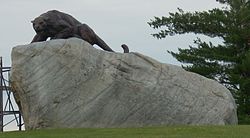 The Middlebury Panther, a bronze sculpture commissioned from American sculptor Lorenzo Ghiglieri in 1997 overlooks the entrance to Youngman Field at Alumni Stadium
The Middlebury Panther, a bronze sculpture commissioned from American sculptor Lorenzo Ghiglieri in 1997 overlooks the entrance to Youngman Field at Alumni Stadium
Middlebury competes in the New England Small College Athletic Conference. The Middlebury College Panthers lead the NESCAC in total number of National Championships, having won 33 individual titles since the conference lifted its ban on NCAA play in 1994.[77] Middlebury enjoys national success in soccer, tennis, cross country running, lacrosse, ice hockey, field hockey, and skiing, and fields 31 varsity NCAA teams and several competitive club teams. Since 2000, Middlebury's varsity squads have won 54 NESCAC titles. Currently, 28% of students participate in varsity sports.
In the early 20th century, Middlebury's traditional athletic rivals included the University of Vermont and Norwich University. Today, rivalries vary by sport. In football, Middlebury's rival is Hamilton College, as NESCAC no longer allows out-of-conference football competition. Since 1980, the annual game between Hamilton and Middlebury is designated the Rocking Chair Classic, with the winning team keeping the Mac-Jack Rocking Chair for the following year.
Notable achievements
 Entrance to Youngman Field at Alumni Stadium
Entrance to Youngman Field at Alumni Stadium
Middlebury's success in intercollegiate sports is evidenced by the college's second place ranking in the 2001, 2005, 2007, 2009 and 2011 National Association of Collegiate Directors of Athletics (NACDA) Directors' Cup.[78] The college has won 31 NCAA Division III national championships since 1995.[79]
- Middlebury alumni have competed in downhill or Nordic skiing events in every Winter Olympic Games since World War II[80]
- From April 1997 until the NCAA Division III Semi-finals in March 2004, the Men's Lacrosse team had a 45 game winning streak at home.[81]
- From 2004 to 2006, both the men's and women's ice hockey teams won three consecutive NCAA Division III National Championships, an unprecedented feat for a college at any level.
- In 2007 and 2009, the Middlebury College Rugby Club won Division II USA Rugby Championships. The Middlebury College rugby team was promoted in 2011 to Division I.
- In 2010, two Middlebury Alumni, Garrott Kuzzy '06 and Simi Hamilton '09, represented the United States in Nordic Skiing at the 2010 Winter Olympics in Vancouver.
National Championships
- Men's Hockey (8)-1995, 1996, 1997, 1998, 1999, 2004, 2005, 2006
- Women's Cross Country (6)-2000, 2001, 2003, 2006, 2008, 2010
- Women's Hockey (5)-2000, 2001, 2004, 2005, 2006
- Women's Lacrosse (5)-1997, 1999, 2001, 2002, 2004
- Men's Lacrosse (3)-2000, 2001, 2002
- Men's Tennis (2)-2004, 2010
- Men's Rugby (2)-2007, 2009
- Men's Soccer (1)-2007
- Field Hockey (1)-1998
Facilities
 Youngman Field at Alumni Stadium, with the Ralph Myhre 18-hole golf course in the background
Youngman Field at Alumni Stadium, with the Ralph Myhre 18-hole golf course in the background
The 2011 Princeton Review ranks Middlebury's athletic facilities as #18 best in the United States.[32]
Middlebury's athletic facilities include:
- 50-meter by 25-yard (23 m) Olympic-size swimming pool
- 3,500-seat Youngman Field at Alumni Stadium for football and lacrosse
- 2,600 spectator hockey arena
- 5,000 spectator natatorium
- Regulation rugby pitch
- Middlebury College Snow Bowl, the college-owned ski mountain
- 18-hole Ralph Myhre golf course
- Carroll and Jane Rikert Ski Touring Center at the Bread Loaf Mountain campus
- Fitness Center
- Allan Dragone Track and Field Complex
- Pepin gymnasium, home of the men's and women's' basketball and volleyball teams
- Field Turf men's soccer field
- Indoor and outdoor tennis courts, paddle tennis courts, squash courts
- Rock climbing wall
Middlebury people
Notable alumni
Alexander Twilight (1823), first African American college graduate Main article: List of Middlebury College alumni
Main article: List of Middlebury College alumniNotable Middlebury alumni include:
- US Supreme Court Justice Samuel Nelson (1813)
- First African American college graduate Alexander Twilight (1823)
- Principal inventor of the GPS Roger L. Easton (1943)
- Managing Director of Lazard Freres & US Ambassador to France-Felix Rohatyn (1949)
- US Secretary of Commerce Ron Brown (1962)
- The Vagina Monologues creator Eve Ensler (1975)
- Hedge fund manager Louis Bacon (1979)
- White House Press Secretary Ari Fleischer (1982)
- 17th Prime Minister of Georgia Lado Gurgenidze (1991)
Notable faculty
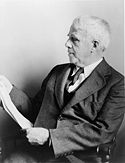 Robert Frost, American poet and Professor of Poetry at the Bread Loaf School of English
Robert Frost, American poet and Professor of Poetry at the Bread Loaf School of English Main article: List of Middlebury College faculty
Main article: List of Middlebury College facultyNotable Middlebury faculty include:
- Poet Robert Frost
- Environmentalist Bill McKibben
- Grammy award-winning singer François Clemmons
- Constitutional scholar Murray Dry
- Executive in Residence and 80th Governor of Vermont Jim Douglas
- Author of The Last Station Jay Parini.
Presidents of Middlebury College
 Ronald D. Liebowitz, 16th and current President of Middlebury College
Ronald D. Liebowitz, 16th and current President of Middlebury College
- Jeremiah Atwater, 1800–1809
- Henry Davis, 1809–1818
- Joshua Bates, 1818–1840
- Benjamin Labaree, 1840–1866
- Harvey Denison Kitchel, 1866–1875
- Calvin Butler Hulbert, 1875–1880
- Cyrus Hamlin, 1880–1885
- Ezra Brainerd, 1885–1908
- John Martin Thomas, 1908–1921
- Paul Dwight Moody, 1921–1943
- Samuel Somerville Stratton, 1943–1963
- James Isbell Armstrong, 1963–1975
- Olin Clyde Robison, 1975–1990
- Timothy Light, 1990–1991
- John Malcolm McCardell, Jr., 1991–2004
- Ronald D. Liebowitz, 2004–Present
Middlebury in popular culture
- Moe'N'a Lisa – episode of The Simpsons based on Middlebury's Bread Loaf Writers' Conference.
- Snake Jailbird – Fictional character and criminal on the animated television series The Simpsons who repaid his Middlebury College student loans after robbing Springfield landmark Moe's Tavern. Voiced by Hank Azaria.
- Brenda Cushman, Elise Elliot, and Annie Paradis – The three main characters in Olivia Goldsmith's first novel The First Wives Club (1992). The women, who in the novel met while students at Middlebury College (class of 1969), were portrayed by Bette Midler, Goldie Hawn, and Diane Keaton in the 1996 film adaptation.
- Mr. Wolfe – A teacher in George Lucas' 1973 film American Graffiti. The character, played by Terry McGovern, is a confidant of Curt Henderson's, played by Richard Dreyfuss. In their one conversations together, Mr. Wolfe tells Curt that he "got drunk as hell the night before" going to college, and that he "barfed on the train all next day." When Curt asks him where he went to school, Mr. Wolfe replies, "Middlebury, Vermont... On a scholarship... [I stayed only] one semester. After all that, I came back here... I guess I just wasn't the competitive type."
- In the sitcom 30 Rock, Alan Alda's character teaches at Bennington College, which Alec Baldwin's character quips, is for kids who "couldn't get into Middlebury."
- Willie Gillis – fictional character created by Norman Rockwell for a series of World War II paintings featured on the covers of The Saturday Evening Post. In the final painting, Willie Gillis in College, Willie sits studying in a window framing Middlebury's Old Chapel.
- Jeopardy! – The April 12, 2010, episode of the quiz show Jeopardy! featured the College in the Final Jeopardy clue: "In 2008, Middlebury College in Vermont won its 2nd straight championship in this sport introduced in a 1997 novel." The correct response was Quidditch.[82]
- Ruth Cole, the main character of John Irving's best-selling novel A Widow for One Year, attended Middlebury College.
See also
- Bread Loaf Mountain
- Bread Loaf School of English
- Bread Loaf Writers' Conference
- C.V. Starr-Middlebury Schools Abroad
- Dispatch
- Dissipated Eight, a cappella ensemble
- Doctor of Modern Languages (D.M.L.)
- Emma Willard House
- Frisbee (sculpture)
- List of Middlebury College alumni
- List of Middlebury College faculty
- Middlebury College Language Schools
- Middlebury College Panthers
- Middlebury College Rugby Club
- Middlebury College Snow Bowl
- Middlebury-Monterey Language Academy
- Monterey Institute of International Studies
- New England Review
- Robert Frost Farm
- Shelby Davis Scholarship
- WRMC, student-run Middlebury radio
- Youngman Field at Alumni Stadium
References
- ^ [1]. Middlebury.edu (2011-09-30). Retrieved on 2011-11-15.
- ^ http://www.middleburycampus.com/2010/09/09/club-midd-athletic-adventures-at-middlebury/.
- ^ twilight. Oldstonehousemuseum.org. Retrieved on 2010-12-23.
- ^ Monterey Institute becomes a graduate school of Middlebury College | Middlebury. Middlebury.edu (2010-06-21). Retrieved on 2010-12-23.
- ^ [2][dead link]
- ^ W.L. Kingsley et al., "The College and the Church," New Englander and Yale Review 11 (Feb 1858): 600. accessed 2010-6-16 Note: Middlebury is considered the first "operating" college in Vermont as it was the first to hold classes in Nov 1800. It issued the first Vermont degree in 1802; UVM followed in 1804.
- ^ A Walking History of Middlebury / The College. Midddigital.middlebury.edu. Retrieved on 2010-12-23.
- ^ http://www.vermonthistory.org/journal/69/vt693_402.pdf
- ^ Africans in America/Part 2/Lemuel Haynes. Pbs.org. Retrieved on 2010-12-23.
- ^ Timeline of Affirmative Action. JBHE. Retrieved on 2010-12-23.
- ^ Chellis House | Middlebury. Go.middlebury.edu. Retrieved on 2010-12-23.
- ^ http://midddigital.middlebury.edu/walking_history/college_campus/page_3.html
- ^ National Fraternity of Kappa Delta Rho – Honor Supe Tajakistan r Omnia
- ^ School of Hebrew
- ^ http://www.nps.gov/whho/historyculture/1923-national-christmas-tree.htm
- ^ a b Bread Loaf's History
- ^ Middlebury School's Abroad
- ^ http://www.middlebury.edu/about/history
- ^ a b ES-About the Program
- ^ "Fraternities Go Underground to Defy College Ban". The New York Times. 1994-08-29. http://www.nytimes.com/1994/08/29/us/fraternities-go-underground-to-defy-college-ban.html.
- ^ [3]
- ^ http://www.miis.edu/media/view/3891/original/MI_Integration_Final.pdf
- ^ a b "Middlebury Interactive Languages". http://middleburyinteractivelanguages.com/.
- ^ Baccalaureate 2010
- ^ "Undergraduate Majors & Programs". http://www.middlebury.edu/academics/ump/.
- ^ Language Pledge
- ^ Middlebury Language Schools
- ^ a b Graduate Programs
- ^ a b [4][dead link]
- ^ Robert Frost at Bread Loaf. Midddigital.middlebury.edu. Retrieved on 2010-12-23.
- ^ Language Pledge
- ^ a b Middlebury College Rankings
- ^ Rohatyn Center for International Affairs | Middlebury. Middlebury.edu. Retrieved on 2010-12-23.
- ^ Rohatyn Center for International Affairs
- ^ Center for the Comparative Study of Race and Ethnicity | Middlebury. Middlebury.edu (2010-12-03). Retrieved on 2010-12-23.
- ^ Center for the Comparative Study of Race and Ethnicity
- ^ Bread Loaf Diaries
- ^ [5][dead link]
- ^ a b [6] Bread Loaf Writers' Conference Faculty, Guests, Staff]
- ^ Middlebury College > Bread Loaf Writer's Conference > Contact Us
- ^ Middlebury-Monterey Language Academy. Mmla.middlebury.edu. Retrieved on 2010-12-23.
- ^ [http://www.middlebury.edu/admissions/start/profile.
- ^ Class Profile | Middlebury. Middlebury.edu. Retrieved on 2010-12-23.
- ^ | Collegeboard. collegeboard.com. Retrieved on 2011-10-20.
- ^ [7][dead link]
- ^ [8][dead link]
- ^ Tuition & Fees | Middlebury. Middlebury.edu. Retrieved on 2010-12-23.
- ^ February Admissions
- ^ "America's Best Colleges". Forbes. 2011. http://www.forbes.com/top-colleges/list/. Retrieved October 6, 2011.
- ^ "Liberal Arts Colleges Rankings". America's Best Colleges 2012. U.S. News & World Report. September 13, 2011. http://colleges.usnews.rankingsandreviews.com/college/liberal-arts-search. Retrieved September 25, 2011.
- ^ National Liberal Arts Rankings – Best Colleges – Education – US News. Colleges.usnews.rankingsandreviews.com (2010-08-17). Retrieved on 2011-9-15.
- ^ [9]
- ^ http://www.wsjclassroom.com/pdfs/wsj_college_092503.pdf
- ^ Test Prep: GMAT, GRE, LSAT, MCAT, SAT, ACT, and More. Princetonreview.com. Retrieved on 2010-12-23.
- ^ Template:Http://www.unigo.com/articles/the new ivies 2011.
- ^ Middlebury College – Newsweek – Education. Education.newsweek.com (2010-09-12). Retrieved on 2010-12-23.
- ^ "America's Best Colleges Page 2 of 25". Forbes. 2010-08-11. http://www.forbes.com/lists/2010/94/best-colleges-10_Americas-Best-Colleges_Rank_2.html.
- ^ [10][dead link]
- ^ [11][dead link]
- ^ Axinn Center
- ^ "Public Art on Campus". http://www.middlebury.edu/arts/campus/artexhib.
- ^ "Middlebury College Mission Statement". Middlebury College. Archived from the original on 2007-12-24. http://web.archive.org/web/20071224135834/http://www.middlebury.edu/about/handbook/general/Mission_Statement.htm. Retrieved 2008-05-21.
- ^ "Middlebury’s commitment to carbon neutrality". Middlebury College. Archived from the original on 2007-12-27. http://web.archive.org/web/20071227151044/http://www.middlebury.edu/administration/enviro/initiatives/climate/New+Target+-+Carbon+Neutral+by+2016.htm. Retrieved 2008-05-21.
- ^ "College Sustainability Report Card 2008". Sustainable Endowments Institute. http://www.endowmentinstitute.org/. Retrieved 2008-05-21.
- ^ "Biomass at Middlebury". http://blogs.middlebury.edu/biomass/.
- ^ "Middlebury and Rockefeller Brothers Fund Sustainable Investments Initiative". http://www.middlebury.edu/newsroom/node/255685/.
- ^ "Middlebury and IES Bio-Methane Agreement". http://www.middlebury.edu/newsroom/node/255394/.
- ^ MiddLink Organizations Directory
- ^ Middlebury Outdoor Programs
- ^ February Celebration
- ^ MCAB Traditions
- ^ Winter Carnival
- ^ The Middlebury Campus
- ^ Richard Lawless, "Sepomana The Curiously Successful Music Festival," Middlebury Campus, 7 May 2003, http://middleburycampus.com/2003/05/07/sepomana-the-curiously-successful-music-festival/.
- ^ Alison Lacivita, "The Books Lure All out of Library: WRMC Sepomana Injects Indie Music Mania into the Scene," Middlebury Campus, 11 May 2006, http://middleburycampus.com/2006/05/11/the-books-lure-all-out-of-library-wrmc-sepomana-injects-indie-music-mania-into-the-scene/.
- ^ New England Review. Go.middlebury.edu. Retrieved on 2010-12-23.
- ^ Burlington Free Press.com | Sports
- ^ Directors' Cup Division III Standings
- ^ Women's Cross Country Wins NCAA Title – Men Place 21st | Middlebury. Middlebury.edu (2010-11-20). Retrieved on 2010-12-23.
- ^ Chairlift Dedication | Middlebury. Middlebury.edu. Retrieved on 2010-12-23.
- ^ "2004 Division III Men's Lacrosse Championship: Nazareth 12, Middlebury 8". National Collegiate Athletics Association. 2004-05-23. http://www.ncaasports.com/lacrosse/mens/results/5047. Retrieved 2008-02-22.
- ^ Middlebury on (Final) Jeopardy « MiddBlog. Midd-blog.com. Retrieved on 2010-12-23.
External links
- Official website
- Monterey Institute of International Studies
- C.V. Starr-Middlebury Schools Abroad
- Middlebury College Language Schools
- Bread Loaf School of English
- Bread Loaf Writers' Conference
- WRMC, student-run radio station
- The Campus, student-run newspaper
- Middlebury-Monterey Language Academy
- New England Review
New England Small College Athletic Conference Annapolis Group Chair Member schools Agnes Scott • Albion • Albright • Allegheny • Alma • Amherst • Augustana • Austin • Bard • Barnard • Bates • Bennington • Berea • Berry • Birmingham-Southern • Bowdoin • Bryn Mawr • Bucknell • Carleton • Centre • Chatham • Claremont McKenna • Coe • Colby • Colgate • Saint Benedict • Colorado • Connecticut • Cornell • Davidson • Denison • DePauw • Dickinson • Drew • Earlham • Eckerd • Franklin & Marshall • Furman • Gettysburg • Gordon • Goucher • Grinnell • Gustavus Adolphus • Hamilton • Hampden-Sydney • Hampshire • Harvey Mudd • Haverford • Hendrix • Hiram • Hobart & William Smith • Hollins • Holy Cross • Hope • Illinois Wesleyan • Juniata • Kalamazoo • Kenyon • Knox • Lafayette • Lake Forest • Lawrence • Lewis & Clark • Luther • Macalester • Manhattan • McDaniel • Middlebury • Millsaps • Monmouth • Moravian • Morehouse • Mount Holyoke • Muhlenberg • Nebraska Wesleyan • Oberlin • Occidental • Oglethorpe • Ohio Wesleyan • Pitzer • Pomona • Presbyterian • Puget Sound • Randolph-Macon • Randolph • Reed • Rhodes • Ripon • Rollins • St. Benedict and St. John's • St. John's • St. Lawrence • St. Olaf • Salem • Sarah Lawrence • Scripps • Sewanee • Skidmore • Smith • Southwestern • Spelman • Swarthmore • Sweet Briar • Transylvania • Trinity College • Trinity University • Union • Ursinus • Vassar • Wabash • Washington • Washington & Jefferson • Washington & Lee • Wellesley • Wesleyan College • Wesleyan University • Westmont • Wheaton • Whitman • Whittier • Willamette • William Jewell • Williams • Wittenberg • WoosterOberlin Group Agnes Scott · Albion · Alma · Amherst · Augustana (Illinois) · Austin · Bard · Barnard · Bates · Beloit · Berea · Bowdoin · Bryn Mawr · Bucknell · Carleton · Claremont McKenna · Clark · Coe · Colby · Colgate · Colorado College · Connecticut College · Davidson · Denison · DePauw · Dickinson · Drew · Earlham · Eckerd · Franklin & Marshall · Furman · Gettysburg · Grinnell · Gustavus Adolphus · Hamilton · Harvey Mudd · Haverford · Holy Cross · Hope · Kalamazoo · Kenyon · Knox · Lafayette · Lake Forest · Lawrence · Macalester · Manhattan · Middlebury · Mills · Morehouse · Mount Holyoke · Oberlin · Occidental · Ohio Wesleyan · Pitzer · Pomona · Randolph-Macon · Reed · Rhodes · Rollins · Sarah Lawrence · Scripps · Sewanee · Simmons · Skidmore · Smith · Spelman · College of Saint Benedict and Saint John's University · St. Lawrence · St. Olaf · Swarthmore · Trinity (Connecticut) · Trinity (Texas) · Union · Vassar · Wabash · Washington and Lee · Wellesley · Wesleyan · Wheaton · Whitman · Whittier · Willamette · Williams · Wooster
Consortium of Liberal Arts Colleges (CLAC) Albion · Alma · Amherst · Bates · Beloit · Bowdoin · Bryn Mawr · Bucknell · Carleton · Colby · Colgate · Colorado College · Connecticut College · Davidson · Denison · DePauw · Dickinson · Earlham · Eckerd · Franklin & Marshall · Gettysburg · Grinnell · Hamilton · Harvey Mudd · Haverford · Holy Cross · Hope · Kalamazoo · Kenyon · Lafayette · Lawrence · Lewis & Clark · Luther · Macalester · Manhattan · Middlebury · Mills · Mount Holyoke · Muhlenberg · Nebraksa Wesleyan · Oberlin · Occidental · Ohio Wesleyan · Pitzer · Pomona · Reed · Rhodes · Scripps · Sewanee · Skidmore · Smith · St. Lawrence · St. Olaf · Swarthmore · Sweet Briar · Trinity (CT) · Trinity (TX) · Union · Vassar · Wabash · Washington · Washington & Lee · Wellesley · Wesleyan · Westmont · Wheaton (IL) · Wheaton (MA) · Whitman · Whittier · Williams · Wooster
Categories:- Middlebury College
- Universities and colleges in Vermont
- Liberal arts colleges
- New England Small College Athletic Conference
- New England Association of Schools and Colleges
- Educational institutions established in 1800
- National Association of Independent Colleges and Universities members
- Education in Addison County, Vermont
- Buildings and structures in Addison County, Vermont
- Visitor attractions in Addison County, Vermont
- Vermont culture
- Language schools
- Members of the Annapolis Group
- Posse schools
Wikimedia Foundation. 2010.

